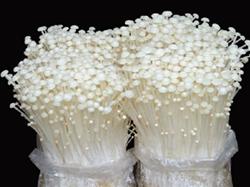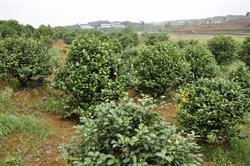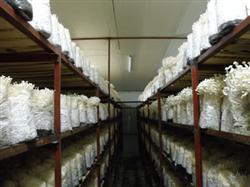Cultivation techniques of Flammulina velutipes: what kind of environment is suitable for the growth of Flammulina velutipes?

What kind of environment is suitable for Flammulina velutipes to grow? Flammulina velutipes is a kind of wood rot fungus, which can make use of monosaccharides, cellulose, lignin and other compounds in wood. However, the ability to decompose wood is weak, hard trees after felling, do not reach a certain degree of decay can not grow fruit bodies. The sawdust of old broad-leaved trees is more suitable for the growth of Flammulina velutipes after accumulation and fermentation. 1. Carbon source: all the carbon nutrients needed by Flammulina velutipes come from organic carbon compounds, such as cellulose, lignin, starch, pectin, pentosans, organic acids and alcohols. Starch is the best, followed by glucose, fructose, sucrose, mannitol, maltose, lactose and galactose, but inulin can not be used. two。 Nitrogen sources: Flammulina velutipes can use a variety of nitrogen sources, among which organic nitrogen is the best, such as peptone, glutamic acid, urea and so on. Natural nitrogen-containing compounds such as beef extract and yeast extract are also good nitrogen sources, and ammonium nitrogen in inorganic nitrogen, such as ammonium sulfate (in the presence of vitamin B1), can also be used, but the utilization of nitrate and nitrite nitrogen is very poor. 3. Inorganic nutrition: the growth and development of Flammulina velutipes also needs a certain amount of inorganic salts, such as potassium dihydrogen phosphate, calcium sulfate, calcium carbonate, ferric sulfate and so on. Flammulina velutipes obtains phosphorus, iron, magnesium and other elements from these inorganic salts. Among them, phosphorus, potassium and magnesium are the most important, and the appropriate concentration is 100 mg to 150 mg per liter of culture medium. 4. Vitamins: Flammulina velutipes is the natural deficiency of vitamin B1 and B2, which must be added by the outside world in order to grow well. There are more vitamins in potato and rice sugar, so there is no need to add vitamins when preparing medium with these materials, but for Flammulina velutipes with sparse mycelium, a small amount of vitamin B1 or B2 (oral VB1, VB2) should be added when preparing mother culture medium. 5. Temperature: temperature is an important factor affecting the growth and development of mycelium and fruiting body of Flammulina velutipes. A large number of spores were formed at 5 ℃ ~ 25 ℃, and were easy to develop into hyphae. The mycelium grew very slowly when the mycelium grew in the range of 3 ℃ ~ 34 ℃, the optimum temperature was 23 ℃ ~ 25 ℃ and 30 ℃ ~ 40 ℃. The hyphae had strong low temperature tolerance and could survive after 138days at-21 ℃. The hyphae had weak resistance to high temperature. The hyphae stopped growing at 34 ℃, and died soon after 34 ℃. Therefore, under natural conditions, the mycelium growth of Flammulina velutipes is not exuberant during the high temperature in summer, and it is easy to form pollen spores. 6. Moisture and humidity: Flammulina velutipes is a hygrophilic fungus, and the hyphae can grow normally in a culture medium with a water content of 60% to 80%. 70% of the water content of the culture material is suitable for cultivation. At this time, the mycelium grows fastest. Too much or too little moisture in the culture material will affect the mycelium growth. When the water content is too high, the mycelium grows slowly, even not long. Even if the fruiting body grows, the base of the stalk is easy to change color. If the water content of the culture material is less than 60%, the mycelium is weak, dysplastic, and the color is gray. The relative humidity of the air also has certain requirements, the mycelium growth stage should be controlled within 60%-70%, the humidity is too high, the pollution rate increases, and the fruiting body development stage should be controlled at 80%-90%. 7. Air: Flammulina velutipes is not sensitive to carbon dioxide, but it also needs enough oxygen during fruiting body growth. Because of its small cap, the indoor ventilation can be less than that of other large caps. The growth of the fruiting body is inhibited during hypoxia, and the carbon dioxide in the air needed for the growth of Flammulina velutipes is 0.03%-0.06%. 8. Light: Flammulina velutipes is a light-aversion edible fungus. The mycelium grows normally in complete darkness and can die in direct sunlight. The normal growth of fruiting body requires illuminance of 2 to 4 lux, or even complete darkness. The light is strong, whether the stalk is long, the umbrella opens prematurely, and the commodity value is low. The edible Flammulina velutipes mainly eats the stalk, the shorter the stalk, the earlier the umbrella is opened, the lower the commodity value is. 9. Acidity and alkalinity: Flammulina velutipes needs weak acid medium. The mycelium could grow on pH3~8.4 Agar medium, but the mycelium growth was the best in the range of pH5.6~6.5. PH5~6 is suitable for the differentiation of primordium and the growth and development of fruiting body. Click to get more Flammulina velutipes planting technology click to get more edible mushroom planting technology
- Prev

How are camellias cultivated?
How are camellias cultivated? Please give an introduction to camellia semi-shade plants, suitable for scattered light growth, fear of direct light exposure, seedlings need shade. However, long-term shade is unfavorable to the growth of camellia, with thin leaves and few flowers, which affects the ornamental value. Adult plants need more light to facilitate flower bud formation and flowering.
- Next

Cultivation techniques of Flammulina velutipes: what is Flammulina velutipes witches' branch disease?
What is Flammulina velutipes witches' branch disease? Please introduce and control Flammulina velutipes with long stalk but not cap, commonly known as Flammulina velutipes witches' broom disease, or Flammulina velutipes, which is a non-infectious physiological disease. When the cultivation bag or bottle changes from mycelium growth to fruiting body formation, mushroom buds grow in clusters and only long stalks are invisible.
Related
- Fuxing push coffee new agricultural production and marketing class: lack of small-scale processing plants
- Jujube rice field leisure farm deep ploughing Yilan for five years to create a space for organic food and play
- Nongyu Farm-A trial of organic papaya for brave women with advanced technology
- Four points for attention in the prevention and control of diseases and insect pests of edible fungi
- How to add nutrient solution to Edible Fungi
- Is there any good way to control edible fungus mites?
- Open Inoculation Technology of Edible Fungi
- Is there any clever way to use fertilizer for edible fungus in winter?
- What agents are used to kill the pathogens of edible fungi in the mushroom shed?
- Rapid drying of Edible Fungi

